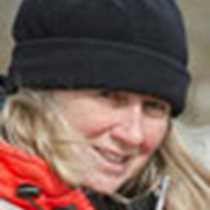Confusing patterns of black and white accented by splashes of red blended with a cacophony of sound and blurred movements. The island rippled with life. From a distance it looked like little more than a large, flat, ashen-tinted rock. As we approached from the southern sea our noses confirmed our suspicion that the islet had been painted white by generations of avian visitors. Soon movement was perceived, its gentle writhing beginnings growing to a climax of frantic flight. The sound of wing beats melded with the creaking calls of thousands of Elegant Terns and the strange "me" pleading of just as many Heermann's Gulls.
On shore we found ourselves amidst the crowded city of nests. Dark bodied gulls with handsome white heads and crimson beaks guarded their simple homes and speckled eggs with fierce defiance. There seemed to be no preference of locale for rocky mounds, sandy flats or vegetated plots all appeared to do as well. The Elegant Terns, in contrast, were as picky about their abode as their royal bearing seemed to convey. Black crests flared from their crowns as orange-red beaks flashed back and forth, always vigilant of the predatory habits of the neighboring gulls. Crowded in the flats, each pair of terns guarded their single egg. From our vantage point, bodies and wings and tails all moved as one and the ground seemed to undulate with their presence. Four hundred thousand birds were here. Ninety-five percent of the world's population of both species depend on this fragment of land and the cornucopia found in the sea surrounding it.
It is not often that one finds oneself an observer of the beginnings of such a plethora of potential new life.




